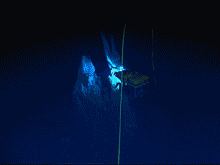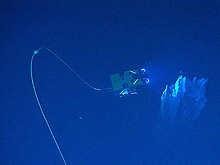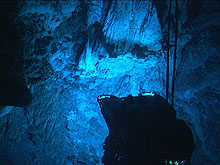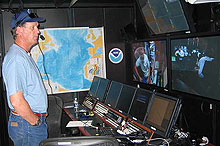

A New Model of Exploration: Co-Chief Scientists Dr. Robert Ballard and Dr. Deborah Kelley watch images of Lost City explorations while working 4500 miles apart. Dr. Ballard stands in the Ship's Control Room in the middle of the Atlantic Ocean and Dr. Kelley sits at University of Washington's Science Control Center in Seattle. Click image for larger view and image credit.
View a visual collection of images from The Lost City 2005 Exploration.
![]() Click image to view a slide show.
Click image to view a slide show.
Mission Summary
Dr. Deborah Kelley
Co-Chief Scientist
Introduction
For nearly 25 years, vigorously venting black smoker systems were believed to typify submarine hydrothermal hot spring systems. Since their initial discovery at the Galapagos Rift in 1977, by Robert Ballard, over 200 sites of active venting have been found along the global mid-ocean ridge spreading network, within back arc basins, and on seamounts. The vibrant colonies of tubeworms, mussels, shrimp, clams and other animals living at these sites were in stark contrast to the relative desert away from the vents. The discovery of life thriving in the absence of sunlight and fueled by volcanic gases fundamentally changed our views about where and how life can live on our planet and perhaps others.
In 2000, the discovery of the Lost City hydrothermal field ![]() at 30°N
on the Atlantis Massif once again rocked the science community.
At this site, located on 1.5 million year old crust nine miles from the
Mid-Atlantic Ridge, carbonate chimneys towered 60 meters (~180 feet)
above the seafloor, venting methane- and hydrogen-rich alkaline fluids
at temperatures up to 91°C (195.8°F). Sampling and imaging with
the 3-person submersible Alvin on
the research ship the Atlantis in 2000 and 2003 (during expeditions
funded by the National Science Foundation) showed that this field was
like no other discovered. Within the porous interior of the chimneys and
on the outer walls thrived dense microbial communities, many involving methane
in their metabolic activity. Perhaps most surprising was that small animals
growing in the pores and small nooks on the outer chimney walls were
low in total biomass, but showed a diversity as high or higher than black
smoker systems on the Mid-Atlantic Ridge. The discovery that hydrothermal
flow was driven by exothermic mineral fluid reactions and cooling within
the underlying mantle rocks and not by cooling of submarine volcanoes opened
entire new areas of the ocean to search for these remarkable ecosystems.
at 30°N
on the Atlantis Massif once again rocked the science community.
At this site, located on 1.5 million year old crust nine miles from the
Mid-Atlantic Ridge, carbonate chimneys towered 60 meters (~180 feet)
above the seafloor, venting methane- and hydrogen-rich alkaline fluids
at temperatures up to 91°C (195.8°F). Sampling and imaging with
the 3-person submersible Alvin on
the research ship the Atlantis in 2000 and 2003 (during expeditions
funded by the National Science Foundation) showed that this field was
like no other discovered. Within the porous interior of the chimneys and
on the outer walls thrived dense microbial communities, many involving methane
in their metabolic activity. Perhaps most surprising was that small animals
growing in the pores and small nooks on the outer chimney walls were
low in total biomass, but showed a diversity as high or higher than black
smoker systems on the Mid-Atlantic Ridge. The discovery that hydrothermal
flow was driven by exothermic mineral fluid reactions and cooling within
the underlying mantle rocks and not by cooling of submarine volcanoes opened
entire new areas of the ocean to search for these remarkable ecosystems.
Lost City 2005
This 2005 expedition set a new benchmark in ocean exploration. Remarkable advances in technology allowed, for the first time, participation of an entire science party housed not on a research vessel, but instead in a Science Command Center located 4500 miles away at the University of Washington (UW). Twenty-one scientists, graduate students and undergraduates formed a team of interdisciplinary researchers from across the US and as far away as Japan and Switzerland. Data and spectacular video imagery were streamed from the IFE robotic vehicles Hercules and Argus up a fiber optic cable, transmitted from the NOAA research vessel the Ronald H. Brown to a satellite, from there to a downlink station in Maine, to Boston where the data were streamed over Internet 2, and off to the University of Rhode Island's (URI's) Inner Space Center, the Science Command Center at the University of Washington, and to the University of New Hampshire. These data and imagery were transported from a water depth of 700 meters (~2100 feet), nearly dead center of the Atlantic ocean, to the University of Washington in ~ 1.5 seconds! Live video, continuously streamed over the Internet, allowed the public to look over our shoulders and see dramatic images of actively venting structures, fish and corals.
This cruise was a stunning technological success and the high definition imagery obtained from Hercules and Argus were truly awe inspiring. The images of Hercules, looking like a small toy against the massive trunk of the 60-m tall edifice called Poseidon, continued to astound the science party throughout the program. These images yielded important overviews of the carbonate monoliths that comprise the core of the Lost City field, providing new insights into their complex growth histories and relationships to vein and fracture networks. Nearly every major edifice in the field was visited and significant portions imaged in detail. Exploration dives to the east and west of the field showed us never before views of the complex terrane and detailed imagery of intensely deformed mantle rocks that directly underlie the field. A new sonar system on Hercules, coupled with a computer controlled mosaicking survey, provided unprecedented high-resolution bathymetric information and impressive views of the 3-story tall parasitic chimney called IMAX.
One of the most impressive aspects of the Lost City ecosystem is the way in which geological, chemical, and biological processes are tightly linked. During this cruise, the pilots took coregistered samples of mantle and carbonate rocks, fluids, and biology to examine these linkages. Onboard the Ronald H. Brown, Billy Brazelton, Kate Buckman, Kevin Roe and Giora Proskurowski conducted time critical subsampling and analyses of the materials recovered.
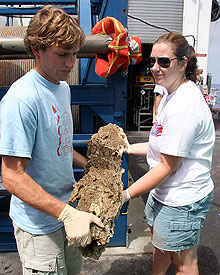
WHOI Postdoctoral student, Giora Proskurawski, and WHOI graduate student, Kate Buckman, carry a meter-long carbonate collected during this expedition's first dive at Lost City. Click image for larger view and image credit.
A major question explored onboard and to be continued shore-based focuses on the microbiological communities and their relationship to larger animals that inhabit the structures. Of special importance was the successful sampling of old-looking carbonate material that will be used to test the hypothesis that venting at Lost City may have been ongoing for 100,000 years or longer.
This expedition was the first experiment in a new way to do science and explore one of the most novel places on Earth. Perhaps one of the most remarkable experiences for me was when Hercules first landed on the bottom and Argus provided an over view of the vehicle ~ 30 m below, hovering over a sedimented basin bounded by a >30° rampart of huge talus blocks. This was a view like no other I had ever seen -- in the dark of the room at the UW with our first views of the bottom, I felt as if I was suddenly in the control room on the ship. Later, walking out into the lit hallway in Mary Gates Hall, I was struck by the sharp contrast of being immersed within the environment of an ocean 4500 miles away and nearly one half mile down and that of a sunny Seattle day with Mt. Rainer in full view.
Finally, I was struck yet once again by how little we know about the oceans, the opportunities for profound new discoveries to be made about how life thrives, survives and expires within some of the most extreme environments on Earth, and how lucky I was to be involved in a project that provided scientists and the public a means to explore the oceans together via telepresence.
Related Links:
http://www.immersionpresents.org
http://www.lostcity.washington.edu
http://www.jasonproject.org/lostcity
Sign up for the Ocean Explorer E-mail Update List.



























